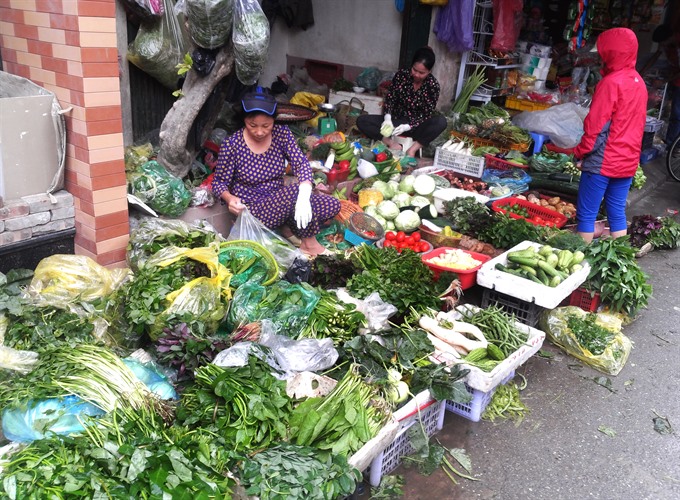 Society
Society

As Hà Nội has rapidly urbanised, many traditional markets have been replaced with supermarkets, convenience stores and trade centres.
 |
| A vegetable stall at Châu Long Market in Hà Nội. - VNS Photo Đoàn Tùng |
HÀ NỘI — As Hà Nội has rapidly urbanised, many traditional markets have been replaced with supermarkets, convenience stores and trade centres.
However, sites converted from traditional markets into modern shopping centres are not as bustling as they used to be.
Twelve years ago, Hàng Da traditional market in the city’s central business area was demolished and replaced by a new model combining the traditional market with a modern shopping mall.
The new indoor location has one underground floor for the traditional market and two above-ground floors for shops offering a wide range of products.
Visiting poorly-patronised Hàng Da shopping mall, Steve Davis, Co-Founder and Executive Vice President of the Project for Public Spaces from the US, was surprised that the mall could maintain operations.
Food markets need modernisation, but that does not mean turning traditional markets into trade centres or putting them under a shopping mall, according to Davis. He has 25 years of experience in market development.
In other countries, market modernisation means building infrastructure, electricity and water systems and providing convenience to customers. But the process must keep markets’ basic functions and unique features, he said.
In Việt Nam, traditional markets are not only a place to exchange goods, but also an inherent part of local culture. Vietnamese markets can be easily set up in any available space, with vendors laying out their goods on makeshift stalls or on street pavements.
Hà Nội now has 60 food markets. Most of them are in a poor state.
As traditional markets sell agricultural and fishery products and vegetables, most of the city’s markets have an untidy look with food safety not being ensured.
According to deputy director of Hà Nội’s Department of Industry and Trade Trần Thị Phương Lan, the city has eight wholesale markets.
“Exchanges do not have contracts,” she said. “Traders can not prove the origins of their products. Both traders and customers do not care much about food safety or the goods’ origins.”
For example, one wholesale market in the city has about 700 traders selling hundreds of tonnes of vegetables and fruits and 30 tonnes of fishery products and meat every day. But hygiene is very poor.
Authorised agencies claimed that controlling products’ origin and quality was difficult.
A representative of the municipal Fishery Sub-department told Vietnam News Agency that it takes three to five days to get the results of a test for anti-biotic residue in seafood. "But there is no regulation to allow officials to temporarily seize seafood while waiting for the result. When the results come in, traders have usually already sold the tested products," he said.
Local authorities’ efforts to upgrade traditional markets and call for private sector investment show a gloomy picture.
According to the city’s Department of Industry and Trade, it is difficult to call for investment in small temporary markets in the rural area.
Many invested markets have been downgraded and lack regular maintenance.
Architect Trần Huy Ánh from Việt Nam’s Architect Association told Vietnam News Agency that as people still demanded to buy products at traditional markets, markets that had not been combined with modern malls were struggling with how to modernise.
"Devising a suitable new model is a real challenge for policymakers," he said.
The Hà Nội’s People’s Committee has recognised the shortcomings of traditional market-shopping mall models and ordered a stop on new ones.
According to the Vietnam News Agency, experts said the failed model changed the market owner. Small traders of traditional markets are no longer in charge.
Commercial profits are not a primary goal. Many market-shopping mall structures take advantage of their prime location to earn profits by renting out office space and storefronts.
With the experience of upgrading more than 500 markets around the world, Davis said "traditional markets can compete with supermarkets if they are upgraded".
For example, according to Davis, roofs are needed to protect sellers and customers from changing weather conditions. Market floors must be made of materials that are easy to clean. Infrastructure maintenance is stagnant. It is time to make a serious commitment to re-investing in traditional markets.
In Việt Nam, Davis and his colleagues plan to study three markets that will be upgraded in Hà Nội – Châu Long, Ngọc Lâm and Hạ-Mê Linh – to search for a new look for Hà Nội’s traditional markets.
The local authorities have given the nod to a pilot project of upgrading and building a number of markets in the city. The project is invested by three joint stock companies that plan to install a fire safety system, electricity and water drainage system within 50 to 90 days. They also plan to build roads around the market area and plant trees.
According to Lê Hồng Thăng, director of the city’s Department of Industry and Trade, the model is relevant after consultations with local and foreign experts.
Markets in poor communes of Sóc Sơn District will be reconstructed under the project, he said. — VNS




